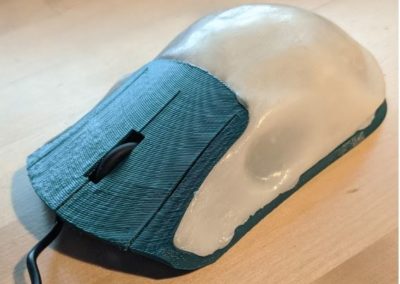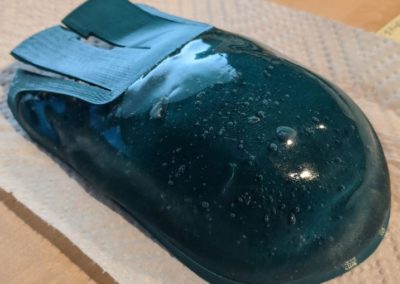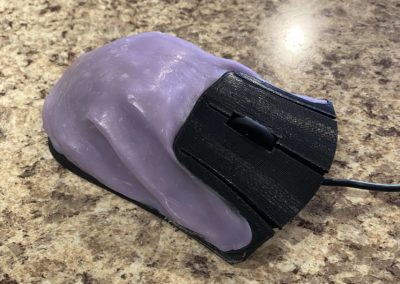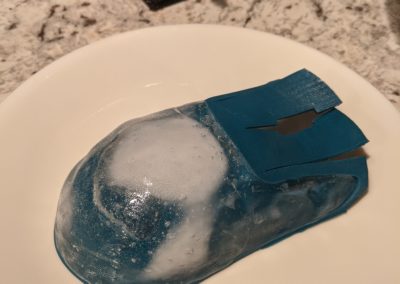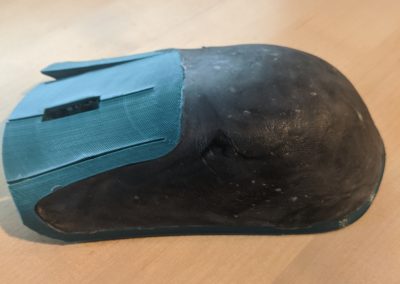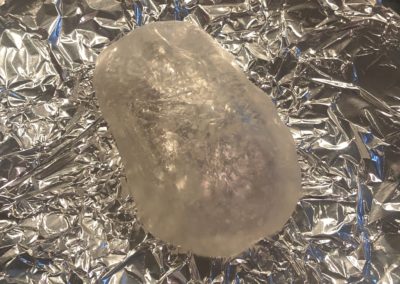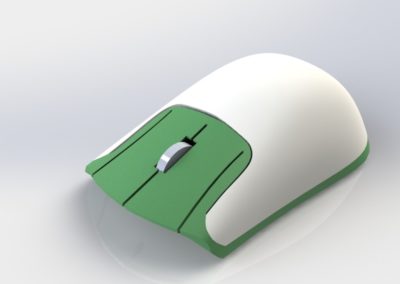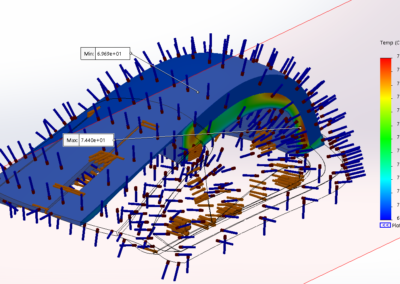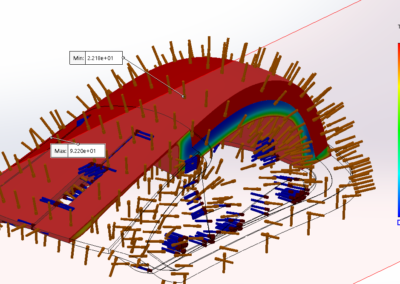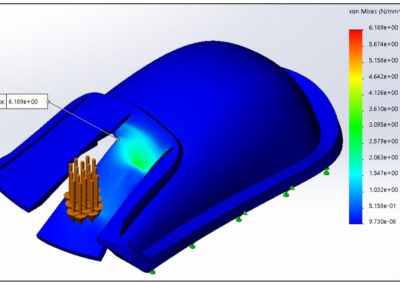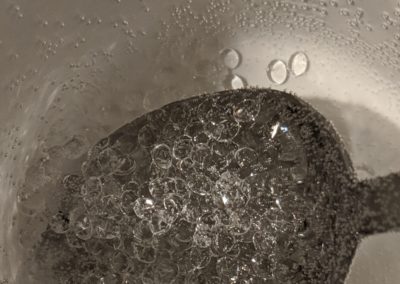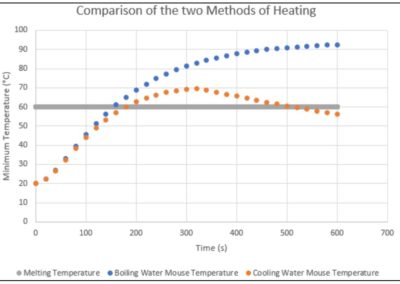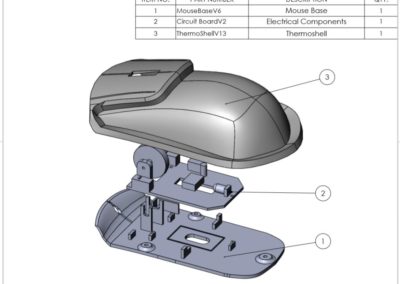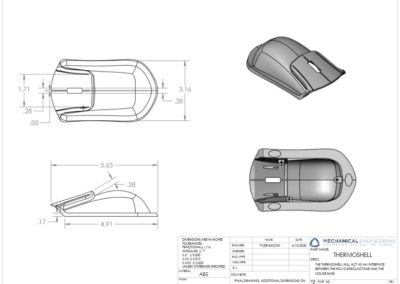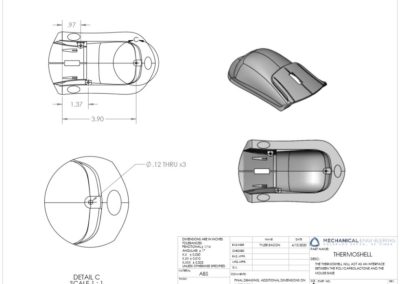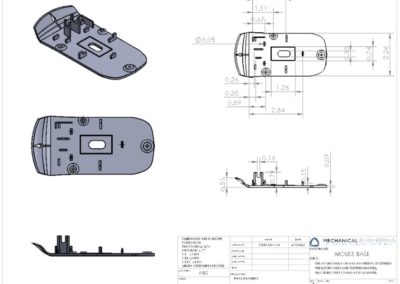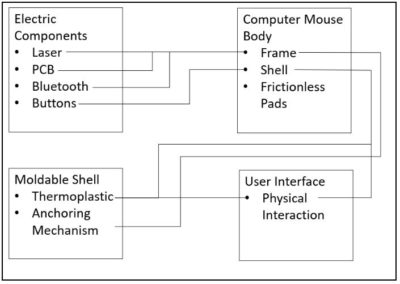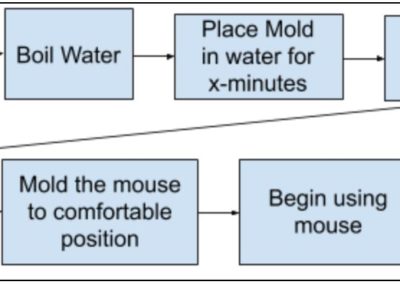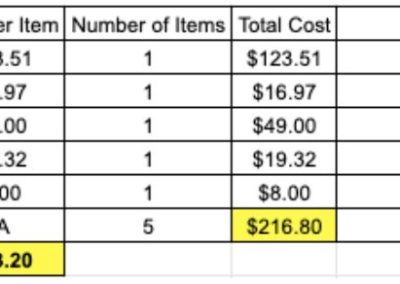Formable Mouse
Overview
Our Formable Mouse (Patent Pending: Application # 16/853,506) was designed to solve the problem that current mice on the market are too rigidly defined in shape. This rigidity leads to decreased comfort for end users as well as increased risk of injury. Previously, mouse designers were highly limited in that they needed to create a product for a majority of the population instead of the individual; we avoided this problem by creating a way for the user to mold the exterior shell of the mouse to their hand, increasing comfort and potentially decreasing the risk of injury to our customers.
This solution was achieved by using two types of thermoplastic to create a single outer shell of the mouse. Upon boiling the design, one thermoplastic becomes soft enough to mold to a person’s hand, while the other remains rigid enough to allow the molded thermoplastic to interface with the rest of the components of the mouse. This was our goal from the inception of the project.
Upon conducting market analysis and interviews with potential customers, we determined that gamers would be the largest market we could hit with such a design. We continued to conduct prototype interviews with our target market to ensure that the product we were designing would bring value to the industry. For prototyping, we used 3D printing and hand molding to create our product. The design was also tested at every level of iteration (of which there were over a dozen) to ensure its quality. It is our intention to bring the product to a design point that can be easily injection molded so that we can further the project and hopefully bring it to market by the year’s end.
Considering that we are a self-made project, we had no former client except for ourselves, Mouse Tailor Group LLC, which was created for the purpose of developing our patent and eventually bringing the product to market. However, Bud Rockhill filled the role of both “client” and business advisor for the sake of Senior Design.
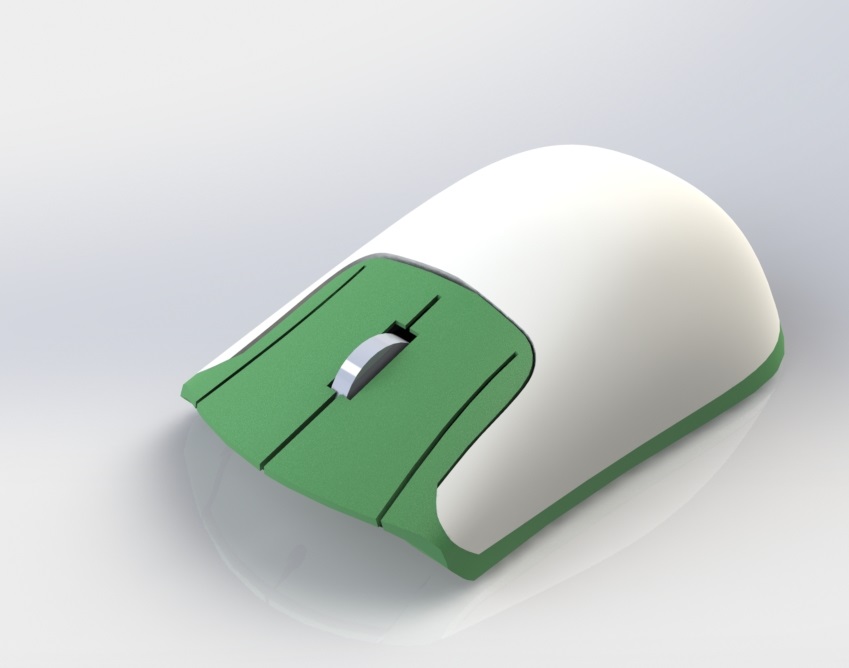
Team Members
- Tyler Bacon
- Cole Boyd
- Gabriel De Souza
- Jacob Humphrey
The Client
- Bud Rockhill
Acknowledgements
Project Advisors: Dr. Abd A. Arkadan and Robin Bullock
Technical Advisors: Prof. Vetzi Karaivanov, Prof. Jennifer Blacklock, Prof. Neal Sullivan, and Prof. Angus Rockett
Funding From: Colorado School of Mines
Additional Thanks to:
Dorsey and Whitney
Roderick O’Dorisio and Perkins Coie
John Persichetti and the EDNS Staff
Kyle Barras
Jim Dallas
All the people we interviewed and were able to test with
Video
Elevator Pitch
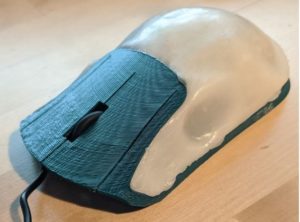
Imagine you are buying your next suit, or maybe even your first suit. You come across the best looking one. Sure, you could buy it and start wearing it immediately, or you could take it to the tailor to get it customer fit, turning it into the perfect suit. Not only does it look great, but it feels even better. We took this same philosophy and came up with a new, innovative idea for a computer mouse.
Now, I’m sure you’re thinking, what is this tailored computer mouse? And who would benefit from it? Base off our customer feedback we decided to target the gaming computer mouse market. Gamers require require higher precision movements and better mice than the average everyday office worker. They are also more in tune with their mouse, like a chef and their knife or a blacksmith and their hammer. Because of this connection to their mouse we are able to get much better feedback.
The problem with current gaming mice is they are designed for one of three different grip types. Within each of these grip types there are dozens of different models from dozens of different companies that you can buy from. Also, we have found that there are variations on grip within each of the three classifications. Not every claw grip is the same. With all of these issues, finding a mouse perfect to you can be hard, time consuming, and expensive. This is the problem we set out to solve. We made a mouse that is one size fits all, so to speak.
Through customer interviews, engineering analysis, and design methodology we came up with a moldable mouse design. The design is even patent pending. It is a mouse that is tailored to the user’s unique hand and grip style. Through iterations and testing we were able to refine the design, and fabricate a final working prototype. This was one of the main goals when we set out with this project. Explore our project, that we are excited to share with you. Please watch our elevator pitch video below our acknowledgements. Thank you!
Design Approach
Our preliminary designs were created to try to encapsulate as many possible solutions to the problem we had previously established while also following constraints that we established to limit the number of possible designs. Two of the constraints that we established were creating a consistent, high level molding process for the mouse as well as a volumetric constraint for each mouse.
We established four, varying preliminary designs which complied with our constraints while following completely different design mentalities. The first design, called the single shell design, consisted of three components: the moldable shell, the shell anchors and the body. The moldable shell of the mouse is a pre-shaped thermoplastic that, when sufficiently heated, can be molded to interlock with the base with the anchors. The heating also allows for molding to the user’s hand. Our second design concept, titled the entire boil, was based around the idea of making the molding process as easy as possible for the user. This design had all the components of the formable mouse preassembled and only required that the user boil, mold, then use the final product. Our third concept, called the pockets design, was based around the idea of optimizing design such that we only applied moldable thermoplastic to areas that the human hand came in contact with. Pockets could hold heated thermoplastic and allow for the shape to change in the specific areas. Our last concept, the double shell design, was composed of two interlocking shells: one which bonded to the thermoplastic and one shell that held the electrical components of the mouse. With the preliminary designs established, we set up a system to rank each design.
We used a design matrix to determine which of our concepts would be selected for final design. The design matrix showed the selection criteria, weight for each criteria which we selected according to the customer needs we established, the rating we assigned to each preliminary design per selection criteria, and a final rank for each. The criteria for selection were: cost, weight, feasibility, ease of use, looks, and added comfort. Using the design matrix, we determined that the single shell (concept 1) and the double shell (concept 4) were equally ranked. With this as the final step, we realized that instead of just expanding on one preliminary design, we could take components that worked from all the concepts to create a final product.
We applied engineering analysis and models to determine whether a mouse we created could perform according to its environment. Our engineering models focused on two components: mechanics of materials and heat transfer. Mechanics of materials was applied directly to the ability to repeatedly click the main two buttons for a large number of cycles without failure. Originally, our design had snap hooks in addition to the main clicking buttons, but we eventually steered our design away from snap hooks which meant there was no need for additional solid mechanics analysis. This was because the snap hooks failed too easily, leading to a frail product that couldn’t attach very well. With solid mechanics addressed, we analyzed the effects that heat flow had on our mouse. We set up two scenarios which could potentially be used to heat up the mouse and used simulation to produce values that we could test. The two different scenarios were heating the mouse from a constant boil and heating the mouse in water that was boiling but was put into a bowl that is cooling in the room temperature air. We also did simulations for the thermoshell in a car on a warm summer’s day in order to understand if there could be unwanted melting. Most of our simulations were either done in SolidWorks Simulation or MATLAB.
In conjunction with engineering models, we also established a failure mode and effects analysis (FMEA) to focus on certain aspects of the mouse which may fail, but are hard to analyze from a technical perspective. The FMEA generated many possible failure modes, but the most troubling failure mode that we encountered was the possibility that water from the molding process could damage the circuitry in the mouse base if the shell was not dried off before attaching the thermoplastic outer shell to the base. We established various testing procedures to ensure that this (and many other risks) were improbable.
Additionally, customer interviews were done with multiple iterations in order to gain a better perspective into what the design could improve upon. These interviews were done by taking potential customers through the molding process and gathering their opinion about how to improve the design. This direct interaction greatly helped the team identify areas to improve.
The engineering analysis and FMEA that we performed gave us two pieces of crucial information: whether or not it was possible for our product to work and base marks that real world experiments should trend toward. We took the values that we collected from our engineering analysis and established tests which best replicated the scenarios used in the engineering analysis and FMEA. We primarily tested means by which we could color the moldable plastic, how screw position impacts the mounting of the base, remoldability of the polycaprolactone from a thermal perspective, PCB water failure in cases where user forget to wipe off the mouse base, a visual observation based study of how individuals perform with the mouse, observations of users with their mouse, and possible solutions for comfort testing.
Through the engineering analysis, FMEA, and testing we were able to modify and improve the design through multiple rounds of iterations. The most critical contributors to modifying the design was customer interviews and testing. The models and FMEA helped modify initially, but these interactions were the most critical. The direct interactions with customers made customer interviews beneficial, and iterative testing allowed for the design to readily be improved. Design experts were also communicated with in order to better understand how to improve the design and think about the design from the customer’s perspective.

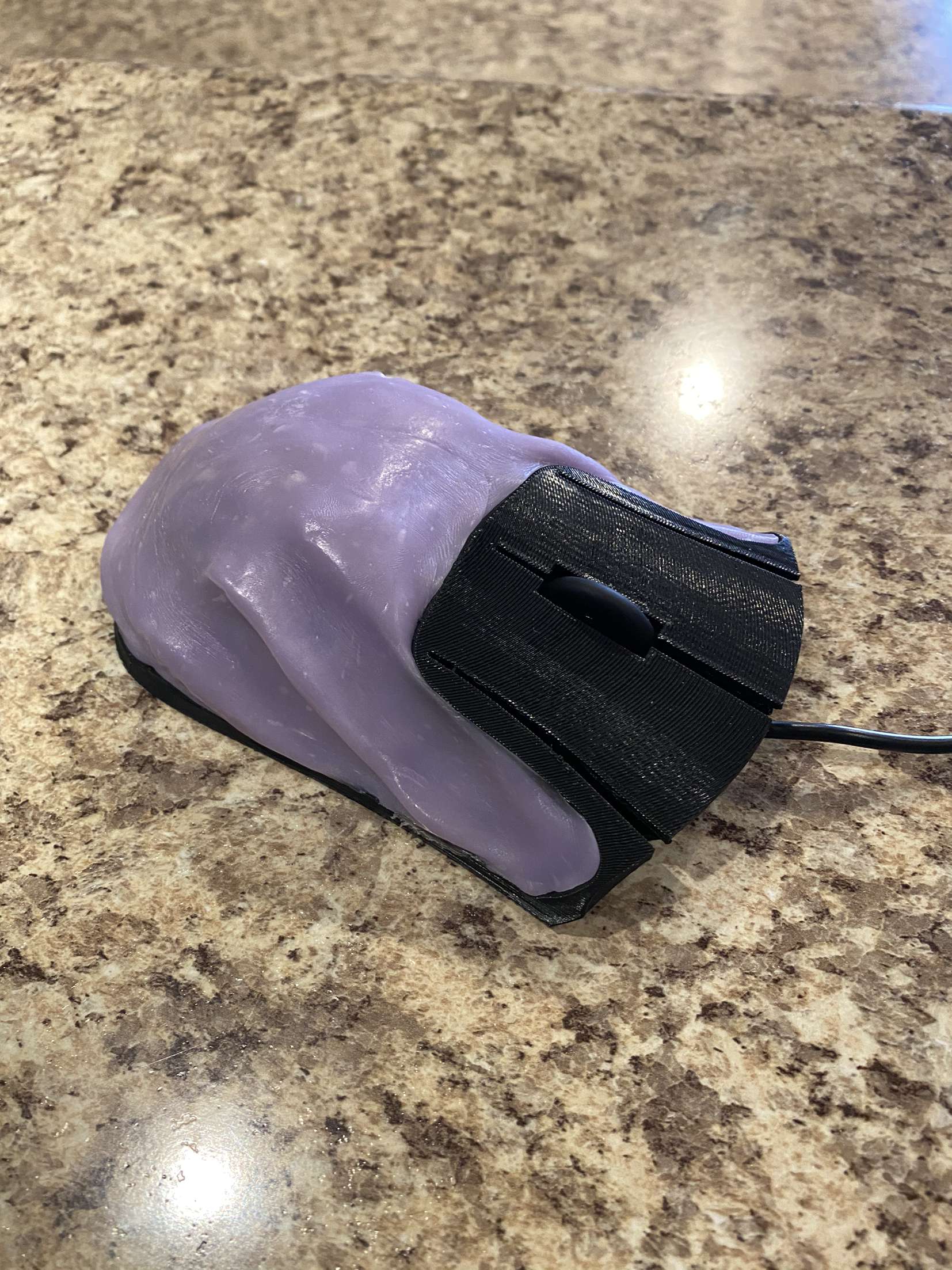
Design Solution
Moldability was achieved through the use of a thermoplastic with a high melting temperature being encased by a thermoplastic with a lower melting temperature. By boiling this composite piece, it allows the low melting temperature thermoplastic to deform to the user’s hand when gripped while the high melting temperature plastic remains solid. This process was designed with the safety of customers in mind. Our product uses the same design mentality as mouth guards and applies it to a market that has never seen the technology. Below are details showing how the design meets the original design goals.
Below is the model and physical prototype made. The model was successfully made into a real product. The real solution was also able to function which was the main goal for the team. The model to the left shows the unformed polycaprolactone, while the physical prototype to the right has a deformed polycaprolactone on an ABS shell.

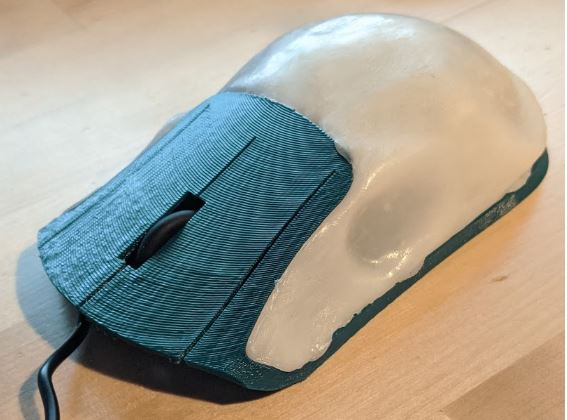
Below are the performance criteria set by the team at the beginning of the semester, and an indication as to how successful the team was with that goal. The team was able to meet all the demands and most of the wants, emphasizing how the final product met the team’s standards.
|
# |
Need Statement |
Pass/Fail |
|
1 |
Minimum functionality of the typical mouse. Two buttons, a scrolling function with a third button, a physical shell, and a position tracker. |
Pass |
|
2 |
More functionality (buttons/customization) seen on high-grade mice. |
Fail |
|
3 |
A more comfortable mouse such that extended use can result in less discomfort. |
Pass |
|
4 |
Increase size and minimize weight to address the concerns of people with arthritis, MS, carpal tunnel, etc. |
Pass |
|
5 |
Greater levels of mouse control for users. |
Pass |
|
6 |
Allows for supination of the hand to reduce stress in forearm and hands. |
Fail |
|
7 |
Balance the precision/performance of the mouse with the strain on wrists, fingers, and shoulders. |
Pass |
|
8 |
Allow for greater grip customization of the mouse. |
Pass |
The key results from the models and tests are summarized below. These allowed for the design to be improved and for different aspects of the design to be verified for the final prototype.
|
Model/Test |
Key Results for Verification or Design |
|
Thermal Model |
The shell should be heated through a continuous boil method, like heating in the microwave. The shell should be heated in the continuous boil for around five minutes in order to balance formability and safety. The shell can easily withstand 30 minutes in a car on a warm summer’s day. |
|
Solid Mechanics Model |
The button is able to deform 1 mm from a 1 N click, so it is within the standards for mitigating strain on hands. The mouse should be able to take well over 800,000 clicks before substantial damage is done from fatigue. Snap hooks are not a viable attachment option, screws are better implemented. |
|
Customer Interviews |
The form and instructions for use were updated through a few different interview iterations and we were able to further verify market potential. From the first round, the average price people said they would pay was $91.67. From the second round people on average said the new version was more comfortable than their current mouse. |
|
Color Test |
The polycaprolactone can be colored to different levels when seeded with a color pellet and worked like taffy. A vacuum chamber may be necessary to remove air pockets in the final product. |
|
Securement Test |
Two screws should be sufficient to secure the base to the thermoshell. Screws also are slightly difficult due to threading, nuts help make it slightly easier. |
|
Re-moldability |
The thermoshell can be reheated multiple times with minimal damage to the thermoshell, and the heating is similar to what models predicted. |
|
PCB Water Damage |
Will be done in the future. This will be done in order to understand if additional means of protection was needed for the PCB. |
|
Player Test |
The player test showed that a perfectly functioning prototype is still not achieved. Work needs to be done for the PCB securement and forming process. |
|
Observing Users Test |
The side walls need to be designed to allow for flicking of the mouse, people may change grip types, and there are additional areas to improve comfort. |
|
Comfort Test |
Will be done in the future. This will be done in order to establish the Mouse Comfort Index for marketing. |
A diagram of the system inputs for the mouse and the outputs expected. The mouse will be mainly interacting with the user through their hand like a typical computer mouse. Much more is expected to go into the mouse than just touching the mouse, just like users expect more than just clicks.

Diagram of how different subsystems interact with each other. This depicts how the mouse was divided and how components allow for the mouse to function well.
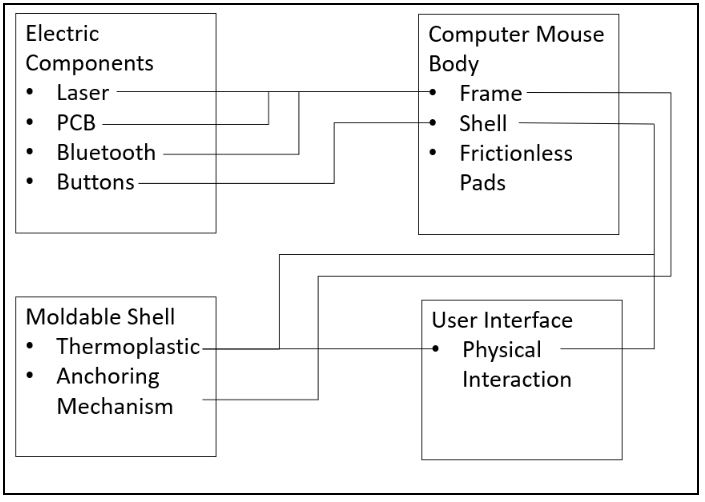
The project came in significantly under budget. This shows how well the planning for the project was and how doing efficient engineering analysis allowed for a quality product to be made. Most of the items were used in order to develop prototypes and help with testing. The only item that was not bought for testing or prototypes was a fee to register as a business in the state of Colorado. This was done in order to develop the business side of the project and helped us in applying for a patent. Below is a table of the costs for the purchased items.

Next Steps
We have a 3-step plan to further the design and bring it to market. These steps are outlined below:
- Redesign for manufacturing and continue design iteration.
- Validate the design through synthetic advertising and other methods.
- Determine distribution methods of the final product.
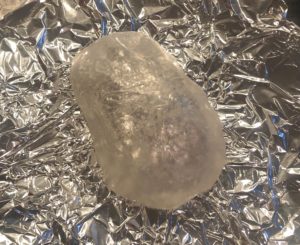
Step 1 is the most direct continuation of the project. It concerns outfitting our design to improve its quality and allow it to be manufactured. Currently there are several design flaws with our current design we wish to ameliorate, including (as discussed) manufacturability, optimal moldability, and overall ergonomics. Currently, the team has identified several ways in which it can make the design more comfortable through formability at no extra cost, and this will be the first thing the team works on achieving after the end of Senior Design.
Step 2 concerns validating the design to ensure it meets a market demand. Now that we have a design, it’s time to reexamine our market strategy to ensure our product solves a problem. One of the ways in which we plan on doing this is through “False Marketing;” we plan on setting up ads that direct to a website that states our product is “Coming Soon” and analyzing the website hits to determine market interest in the product. It is so-called “False Marketing” because the product is not yet on sale; we do not plan on using deceit in any way.
Step 3 concerns figuring out distribution methods of the product. Will we distribute directly to consumers? Will we sell to retailers? Which ones? These and more are questions the team needs to answer to get the product selling and should come after the first two steps.
Meet the Team
Tyler Bacon
 Previously an Athletic Training Major and former college athlete, Tyler decided to change is academic path and pursue his strengths in math and physics and is now expecting to graduate as a mechanical engineer. Tyler was a TA for Intro to Scientific Computing and President of the club volleyball team. Outside of the classroom, he enjoys golfing, fishing, hiking, backpacking, camping, and playing video games.
Previously an Athletic Training Major and former college athlete, Tyler decided to change is academic path and pursue his strengths in math and physics and is now expecting to graduate as a mechanical engineer. Tyler was a TA for Intro to Scientific Computing and President of the club volleyball team. Outside of the classroom, he enjoys golfing, fishing, hiking, backpacking, camping, and playing video games.
Cole Boyd
 Cole is a graduating mechanical engineering student from Omaha, Nebraska. Cole focused his mechanical engineering on fluids and thermal systems and got minors in metallurgical and materials engineering and mathematics. Outside of the classroom Cole likes volunteering, and self learning. He has been involved in a variety of tutoring opportunities around Golden and ran the E-Day trebuchet competition the past three years. He taught himself how to code this past summer, and likes to play soccer or football for fun.
Cole is a graduating mechanical engineering student from Omaha, Nebraska. Cole focused his mechanical engineering on fluids and thermal systems and got minors in metallurgical and materials engineering and mathematics. Outside of the classroom Cole likes volunteering, and self learning. He has been involved in a variety of tutoring opportunities around Golden and ran the E-Day trebuchet competition the past three years. He taught himself how to code this past summer, and likes to play soccer or football for fun.
Gabriel De Souza
 Gabe a is mechanical engineering student from Connecticut that is about to complete his final semester at Colorado School of mines. His main interests include the utilities which is the industry he plans on working in after he graduates. In his free time he likes researching potential projects to work on and accruing knowledge outside his field like gardening. Gabe has had 3 internships in his time at CSM and is planning on working at HDR once he graduates.
Gabe a is mechanical engineering student from Connecticut that is about to complete his final semester at Colorado School of mines. His main interests include the utilities which is the industry he plans on working in after he graduates. In his free time he likes researching potential projects to work on and accruing knowledge outside his field like gardening. Gabe has had 3 internships in his time at CSM and is planning on working at HDR once he graduates.
Jacob Humphrey
 Jacob is graduating as a Mechanical Engineer native to Denver. He is most interested in the aerospace and energy industries, and in his free time, he enjoys his hobby as a car mechanic, hiking, camping, and photography.
Jacob is graduating as a Mechanical Engineer native to Denver. He is most interested in the aerospace and energy industries, and in his free time, he enjoys his hobby as a car mechanic, hiking, camping, and photography.
